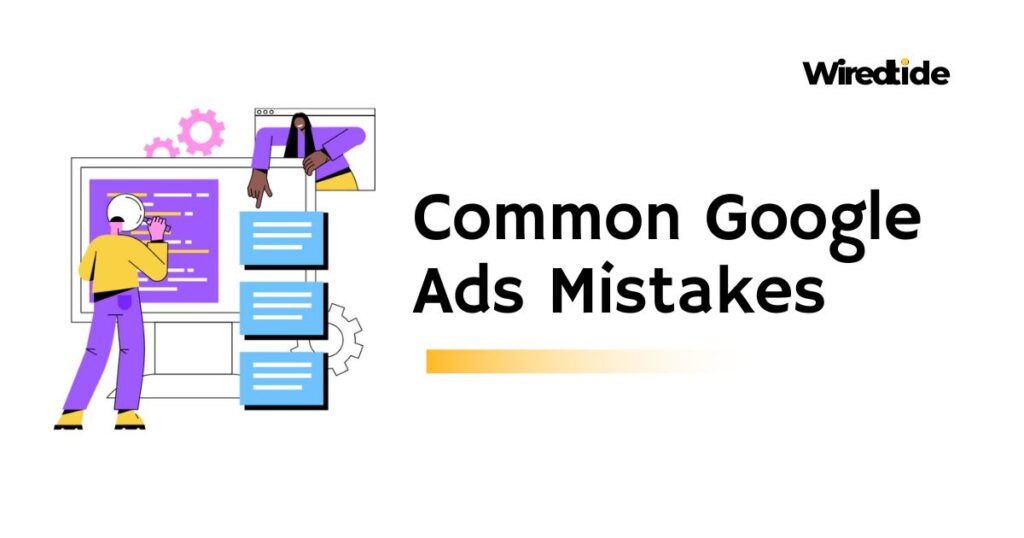Google Ads is a powerful platform for businesses looking to reach their target audience and drive conversions. With over 246 million unique visitors in the United States alone, it offers unparalleled reach and targeting capabilities. However, many advertisers, especially those new to the platform, often fall into common traps that can waste budgets and hinder performance.
In this article, we’ll explore the most prevalent Google Ads mistakes and provide actionable strategies to avoid them.
Navigating the complexities of Google Ads can be daunting. While the platform presents incredible opportunities for increasing visibility and conversions, missteps in campaign setup and execution can lead to wasted budgets and missed opportunities.
This guide highlights ten common mistakes that can derail your Google Ads campaigns and provides actionable strategies to help you avoid them. By understanding these pitfalls, you can enhance your advertising effectiveness and achieve better results.
Poor Keyword Research
Keyword research is the foundation of any successful Google Ads campaign. Many advertisers either choose keywords too broadly or too narrowly, leading to irrelevant clicks or missed opportunities.
How to Avoid This Mistake While Select Keyword Research
- Use Keyword Tools: Utilize tools like Google’s Keyword Planner, Ahrefs, or SEMrush to find keywords relevant to your business.
- Focus on Long-Tail Keywords: Long-tail keywords often have lower competition and can attract more qualified leads.
- Analyze Competitors: Look at the keywords your competitors are targeting to identify gaps and opportunities.
Ignoring Negative Keywords
Negative keywords help prevent your ads from showing up for irrelevant searches, which can waste your budget.
How to Avoid This Mistake
- Regularly Review Search Terms: Monitor the search terms that trigger your ads and add irrelevant ones as negative keywords.
- Think Like Your Audience: Consider what terms potential customers might use that are not relevant to your offerings.
Not Utilizing Ad Extensions
Ad extensions provide additional information to your ads, such as location, phone numbers, or links to specific pages on your site. Ignoring them can lead to lower click-through rates (CTR).
How to Avoid This Mistake:
- Leverage Different Types of Extensions: Use sitelink, callout, and structured snippet extensions to enhance your ads.
- Update Extensions Regularly: Keep your extensions current with relevant promotions or business changes.
Overlooking Quality Score
Quality Score is a critical metric that Google uses to determine your ad rank and CPC. A low Quality Score can increase your costs and reduce ad visibility.
How to Avoid This Mistake:
- Optimize Landing Pages: Ensure that your landing pages are relevant to your ads and provide a good user experience.
- Improve Ad Relevance: Write compelling ad copy that closely matches your targeted keywords.
Inadequate Tracking and Analytics
Without proper tracking, it’s impossible to determine the effectiveness of your campaigns. Many advertisers fail to set up conversion tracking or Google Analytics properly.
How to Avoid This Mistake:
- Set Up Conversion Tracking: Use Google Ads and Google Analytics to track conversions and user behavior on your site.
- Analyze Data Regularly: Regularly review performance data to make informed decisions and adjustments.
Failing to A/B Test Ads
A/B testing allows you to compare different ad variations to see which performs better. Skipping this step can result in missed opportunities for optimization.
How to Avoid This Mistake:
- Test One Element at a Time: Focus on changing one variable, such as headlines or call-to-action phrases, to accurately assess performance.
- Implement Changes Based on Results: Use the insights gained from A/B tests to refine your ad strategy.
Neglecting Mobile Optimization
With the majority of users accessing the web via mobile devices, neglecting mobile optimization can lead to missed opportunities.
How to Avoid This Mistake:
- Create Mobile-Friendly Landing Pages: Ensure your landing pages are responsive and provide a good user experience on mobile devices.
- Use Mobile-Specific Ad Campaigns: Consider setting up separate campaigns targeting mobile users to optimize your messaging.
Using Default Campaign Settings
Many advertisers fail to customize their campaign settings, opting for default options that may not align with their specific goals.
How to Avoid This Mistake:
- Define Specific Goals: Set campaign-specific goals that reflect the desired actions from your target audience. For instance, a campaign focused on brand awareness might prioritize different conversion metrics than one aimed at generating sales.
- Align Marketing Objectives: Choose a marketing objective that corresponds with your goals. If your objective is to increase sales, select conversion goals like “Purchase” or “Add to Cart.”
- Customize Networks: Consider excluding Google Search Partners and Display Network if your primary goal is to optimize for specific audiences, allowing for more controlled ad spend.
Poor Campaign Structure
A well-organized campaign structure is crucial for efficient spending and scalability. However, many advertisers struggle with proper organization.
How to Avoid This Mistake:
- Establish the Right Number of Campaigns: The number of campaigns should be tailored to your business objectives. For example, if targeting specific regions, create separate campaigns to manage budgets effectively.
- Theme Ad Groups: Organize ad groups around specific themes or services. For example, a home improvement business might create separate ad groups for kitchen and bathroom remodeling to enhance relevance and ad copy effectiveness.
- Limit Keywords in Ad Groups: Keep 15-25 keywords per ad group, ensuring they align with the ad copy and landing pages for a seamless user experience.
Lack of Keyword Diversity
Relying on a narrow set of keywords can limit your campaign’s reach and effectiveness.
How to Avoid This Mistake:
- Balance Search Volume: Incorporate a mix of low- and high-volume keywords to maximize traffic potential. Low-volume keywords are less competitive, while high-volume keywords can drive significant traffic.
- Understand Search Intent: Use a blend of informational, navigational, commercial, and transactional keywords to cater to various user needs and intents.
- Utilize Different Match Types: Implement a combination of Broad, Phrase, and Exact match types to enhance targeting while controlling relevance.
Ignoring Search Terms Reports
Many advertisers overlook the importance of monitoring search terms driving clicks to their ads, leading to wasted budgets.
How to Avoid This Mistake:
- Regularly Review Reports: Monitor search terms reports to identify which keywords are delivering relevant traffic and which are not. This allows you to exclude irrelevant keywords and discover new opportunities.
- Adjust Broad Match Settings: While Broad match can expand your reach, it requires diligent monitoring to prevent irrelevant clicks. Use negative keywords to refine your targeting.
Low-Grade Ad Copy
Compelling ad copy is crucial for capturing attention and driving conversions. Generic or uninspired ads can lead to poor performance.
How to Avoid This Mistake:
- Craft Engaging Headlines: Use a mix of keyword-focused headlines, unique value propositions, and clear calls to action.
- Use Responsive Search Ads (RSAs): Implement RSAs to test multiple headlines and descriptions automatically, helping to improve ad performance.
- Regularly Test and Optimize: Continually review and refine ad copy based on performance metrics.
Ineffective Landing Pages
A poorly designed landing page can significantly reduce conversion rates and increase bounce rates.
How to Avoid This Mistake:
- Simplify Layout and Design: Ensure a clear, focused layout with minimal navigation. Users should have an easy path to the desired action without distractions.
- Ensure Content Relevance: Your landing page should reflect the ad copy and targeted keywords, featuring a strong unique value proposition and clear call-to-action.
- Optimize for Mobile: As mobile traffic grows, make sure landing pages are mobile-friendly, fast-loading, and easy to navigate.
Wrong Bidding Strategies
Using inappropriate bidding strategies can drain your budget and reduce campaign effectiveness.
How to Avoid This Mistake:
- Choose the Right Bidding Strategy: Test different bidding strategies based on your campaign goals. For instance, Target CPA can be effective for conversion-driven campaigns.
- Monitor Performance: Regularly assess campaign performance and adjust bidding strategies accordingly to ensure optimal results.
Deficient Audience Targeting
Misunderstanding your audience can lead to wasted ad spend and missed opportunities.
How to Avoid This Mistake:
- Analyze Audience Demographics: Understand your audience’s demographics, interests, and behaviors to ensure your ads reach the right people.
- Utilize Retargeting: Implement retargeting campaigns to engage users who have previously interacted with your website, which can improve conversion rates.
Key Takeaway
Avoiding these common Google Ads mistakes is crucial for maximizing your campaign’s effectiveness and achieving a strong return on investment. With focus on tailored campaign settings, a well-structured approach, diverse keyword strategies, compelling ad copy, effective landing pages, appropriate bidding, precise audience targeting, leveraging ad assets, and robust tracking, you can navigate the complexities of Google Ads with confidence.
If you found this article helpful, please share it with your network and leave a comment below with your experiences or questions about Google Ads in digital marketing. Let’s foster a community of learning and success!
For more insights, check out Google’s Ads Help Center for additional resources and best practices.




